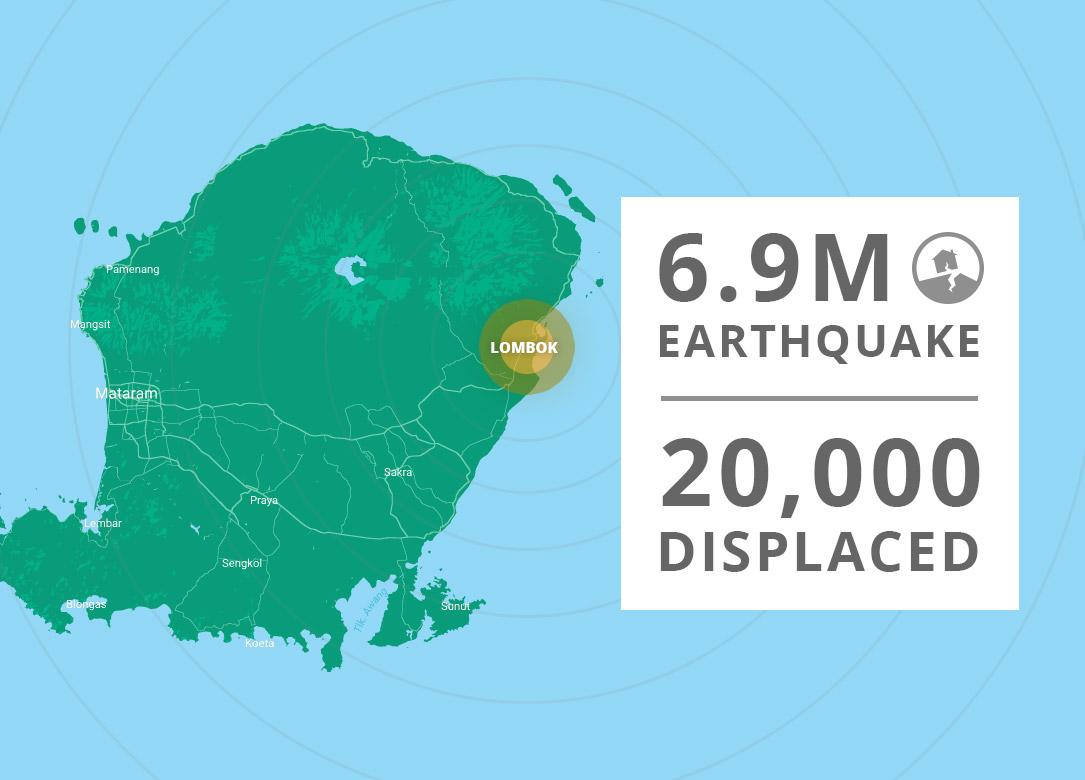On Sunday 29 July, the island of Lombok in Indonesia was violently struck by a 6.4 magnitude earthquake, leaving at least 17 people dead and hundreds more injured.
The disaster was followed by 66 aftershocks with a maximum recorded magnitude of 5.7. Thousands of homes have been either damaged or completely flattened, leaving families with nothing.
But the disaster did not stop there. Less than a week after the initial quake, an even more devastating 6.9 magnitude earthquake hit the island. A tsunami alert was issued but lifted shortly after.
A number of aftershocks have continued to rock the island, spreading terror and panic to local families and tourists. The aftershocks have been felt in neighbouring islands Bali, Jember and Sidoarjo.
This devastating quake has killed nearly 100 people so far. At least 20,000 men, women and children have been left homeless and urgently need shelter.
ASSESSING THE SITUATION
We’re sending a team of highly-trained volunteers to assess the situation on the ground in Indonesia.
The team, consisting of two Response Team Volunteers, will be working with local Rotary contacts and liaising with local authorities to understand whether and how we can help families severely affected by the disaster.
We currently have ShelterBox stock in the region which we could use to support families, if needed.
Meanwhile we will continue to monitor the situation, including the aftershocks and their impact.

WHERE IS LOMBOK?

The island of Lombok is located in West Nusa Tenggara province, in Indonesia. It’s situated to the east of Bali on the other side of the Lombok Strait. The capital, and largest city on the island, is Mataram.
Lombok is a popular tourist destination, with thousands of people from around the world flocking to the island every year. Lombok’s main tourist attractions are its beaches and hiking trails.
Whilst tourists are able to evacuate to their homes, thousands of local families have nothing left and are in urgent need of shelter.
Earthquakes 101
WHAT IS AN EARTHQUAKE?
An earthquake happens when pieces of the earth’s surface rub together, causing the ground to shake.
WHY DO EARTHQUAKES HAPPEN?
Although the ground we walk on may seem solid, it is actually made of huge pieces of flat rock which together, create a kind of patchwork.
These flat pieces of rock are called plates and are constantly moving, although this usually happens so slowly we don’t even notice.
Sometimes these plates get stuck and pressure builds up until one of the plates is forced to give way – this can cause the ground across a wide area to vibrate violently.
WHAT ARE THE EFFECTS?
The size of an earthquake is usually measured by a system called the ‘Richter Scale’. Earthquakes that measure below 4 on this scale are unlikely to cause any damage and those below 2 will usually not even be felt.
However, earthquakes above 5 on the Richter Scale will cause damage and those above 7 are considered major earthquakes. These larger earthquakes can result in buildings being destroyed or so badly damaged they are too dangerous to live in.
WHAT ARE AFTERSHOCKS?
Aftershocks are earthquakes that follow the largest shock of an earthquake sequence.
They are smaller than the initial, main earthquakes and within 1-2 rupture lengths distance from the mainshock.
Aftershocks can continue over a period of weeks, months, or even years. In general, the larger the mainshock, the larger and more numerous the aftershocks, and the longer they will continue.
RESPONDING ALL OVER THE WORLD
We support the most remote communities across the world that have been affected by disaster.
We go the extra mile to find the most vulnerable families whose lives have been devastated by disaster. Our work isn’t done until no family is left without shelter.
